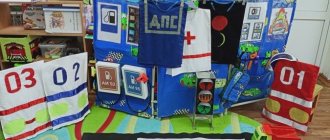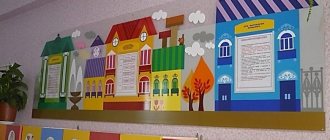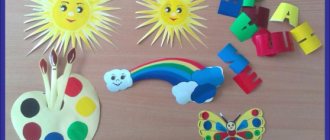Environmental project “Good Mood Corner”
Ecological project
"Good Mood Corner"
Updating the problem.
In our difficult life, we so often lack a good mood. Based on the children’s survey, as well as mini-essays on the topic “Beautiful Injustice”, written under the motto “What shocked me most,” together with the children we decided to create a living corner. After all, our children are kind, sensitive, dreaming of being useful, caring for someone, striving to participate in new activities where they show themselves well.
Objectives of the study
- Learn to work with various sources of information;
- Develop cognitive activity, intellectual and creative abilities, initiative, independence;
- Develop an emotional and aesthetic attitude towards nature and image objects;
- Develop communication skills (work in a creative group);
Research objectives
- Study the living conditions of plants and animals indoors;
- Investigate the environmental factors of the premises;
- Identify the most popular plants and pets in school gardening;
- Identify the centers of origin of popular indoor plants;
- Study the rules and methods of placing plants and animals indoors.
Research methods
- Collecting information on indoor plants and animals from various sources: fiction, scientific and popular science literature, studying the results of activities.
Modeling the placement of indoor plants and animals taking into account the rules of phytodesign.
- Methods of theoretical research (inductive and deductive methods).
Basic expert groups
Statisticians Ecologists Geographers Phytodesigners Zoologists
Project content
I.
_
Organizational stage STATISTICS
- Study the species composition of the school's indoor plants.
- Determine which plants are most often used for landscaping school premises.
- Present the research results in graphical form.
- Conduct a promotional campaign among school students and residents of the neighborhood
Geographers
- Place business cards of popular indoor plants and the most popular representatives of the living area on a map of the natural areas of the continents.
- Study theoretical materials on the characteristics of land biomes.
- Determine how plants are adapted to exist in certain natural conditions.
- Draw a conclusion about the origin of the main groups of popular indoor plants.
Ecologists
- Set the orientation of the room windows to the sides of the horizon.
- Using various instruments, study the complex of abiotic environmental factors that determine the conditions for the existence of plants indoors. Determine: temperature, air humidity, lighting intensity. Present research results in table form
II. Project implementation
With tatista
- Production of advertising leaflets and carrying out advertising campaigns.
- Processing the results of the survey and presenting them in the form of a diagram. Making a wall newspaper “Living Corner of Good Mood”.
Progress of the study
Geographers and zoologists
1. Carrying out research work using the method of A.I. Savenkov on the topic “Indoor plants and inhabitants of a living corner.” 2. Let's write a fairy tale! "A Tale about a Living Daredevil's Tenant." 3. Let's write a letter! A letter to the inhabitants of the living corner “Grow Healthily.”
Phytodesigners
- Operation “Living corner in the apartment” Interaction with communities: kindergarten No. 57, secondary school No. 40, secondary school No. 24
- Meeting with the designer
- Independent preparation of phytodesign projects
Ecologists
- Care and observation of plants and animals.
- Excursion to the ostrich farm “Visiting Baba Frosya.”
- Studying the living conditions of plants, rules and methods of placing them indoors.
- Conducting experiments
Introduction to fiction
- Familiarization with works of popular science and fiction with an environmental focus.
- Visiting city libraries “Writers and poets visiting nature”
- Reading legends, fairy tales, poems, riddles about medicinal plants.
Drawing:
- Development of graphic skills and creative thinking.
- “Our friends are houseplants”, “My little friend”, “Who, who lives in the house?”
- Exhibition of drawings “Magic plants”, “Together a friendly family”
- Decorative drawing
Application:
Development of graphic skills and creative thinking.
“Our friends are green friends”, “My little friend”, “Who, who lives in the house?”
Exhibition of drawings “Amazing Friends”, “More Fun Together”
III. Summarizing
Conclusions of zoologists
- The most common representatives of the living corner: among birds - the budgie, among rodents - guinea pig, hamster, among reptiles - turtle;
- We studied the species composition of each group, origin, living conditions, and maintenance features of the inhabitants of the living area;
- Monitored the correct maintenance of the inhabitants of the living area in a school environment in accordance with generally accepted standards.
Conclusions of phytodesigners
- You can transform the room in which you work or relax into an oasis, where beauty and comfort reign, where the harmony of nature and man reigns, if you correctly place individual plants or entire compositions.
- Basic rules of phytodesign: color harmony, correct selection of dishes, reliability of fastenings of flower beds and flowerpots; in large rooms, free-standing plants or compositions of tall plants are used; for small rooms, vertical compositions of small plants are preferred.
Geographers' conclusions
- Most indoor plants come from tropical, subtropical and desert regions.
- When growing indoor plants, it is necessary to take into account the biological characteristics formed under the influence of the natural and climatic conditions of their places of origin.
- Conclusions of ecologists
- The living conditions for plants in the biology classroom of MBOU “Secondary School No. 12” are favorable, since the complex of abiotic environmental factors (illumination, humidity, temperature) meets the standards.
- We recommend using more medicinal plants in landscaping (aloe, kalanchoe, basil) and “living conditioner” - chlorophytum crested
Conclusions of statisticians
- In indoor landscaping, plants belonging to five groups are used: decorative deciduous, beautifully flowering, ampelous, climbing, and bulbous.
- The most popular plants in MBOU "Secondary School No. 12" are: chlorophytum, nephrolepis, begonias, syngonium, hibiscus, monstera, aspidistra, sansevieria.
- In schools, it is best to grow simple, undemanding plants that bloom easily and abundantly, reproduce easily, and can be cared for by children.
Project progress report. Project protection.
Conclusions on the project
- When placing indoor plants, it is necessary to comply with the plants' requirements for lighting, temperature and humidity conditions, and also take into account biological characteristics formed under the influence of natural and climatic conditions.
- The complex of environmental factors in a living area is favorable for the existence of many indoor plants.
- The most popular in landscaping are chlorophytum crested, ferns, begonias, syngonium, and Chinese hibiscus. Children are engaged in business with interest after school. in a living corner.
- The appearance of smiles on the faces of people visiting the living area.
How to make a corner of privacy with your own hands
The Federal State Educational Standards standards impose certain requirements on the corner of solitude:
Note! In the corner of privacy, you can make a window that allows you to periodically observe the child to make sure he is safe and well. However, it should not violate the baby’s personal space.
Ideas for decorating a corner
When creating the design of a corner of solitude, the teacher should focus on the age of his charges. For the younger group of preschool educational institutions, it is relevant to design a space with a low, narrow entrance. The child will feel comfortable and safe in such an environment.
For other age groups, larger spaces such as a tent or house are suitable, the entrance to which can be curtained with a piece of fabric or covered with a screen. Instead of toys, in such an area you can place items exclusively for educational games or other activities:
Soft toys will come in handy
There can be several options for creating frames for tents:








